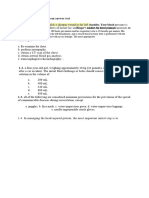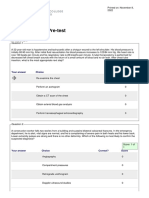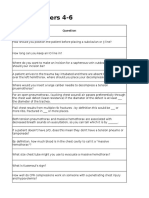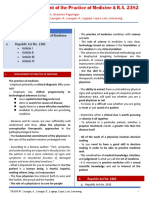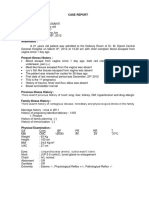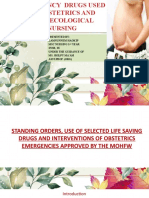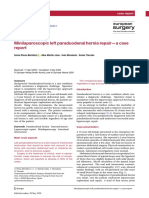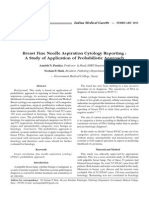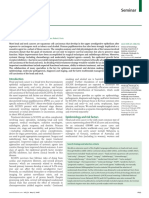Post Test
1. Which one of the findings below requires a definitive airway in trauma patients?
A. A facial laceration
B. Repeated vomiting
C. Partial thickness facial burns, cough, and hoarseness
D. Sternal fracture
E. Glasgow Coma Scale score of 12
2. Which one of the following statement is correct?
A. Cerebral contusion may coalesce to form an intracerebral hematoma
B. Epidural hematomas are usually seen in the frontal region
C. Subdural hematomas are caused by injury to the middle meningeal artery
D. Subdural hematomas typically have a lenticular shape on CT
E. The associated brain damage is more severe in epidural hematomas
3. A 47 years old house painter is brought to the hospital after falling 6 mteres (20 feet) from a
ladder and landing strandling a fence. Examination of his perineum reveals extensive
ecchymosis. There is blood in the external urethral nicatus. The initial diagnostic study for
evaluation of the urinary tract in this patient should be:
A. cytoscopy
B. cystography
C. intravenous pyelography
D. CT scan
E. retrograde urethrography
4. Which of the following statements is false concerning Rh isoimmunization in pregnant trauma
patients?
A. It occurs in blunt or penetrating abdominal trauma
B. It is produced by minor degrees fetomaternal hemorrhage
C. Rh immunoglobulin therapy should be administered to pregnant females who have
sustaine a gunshot wound to the leg
D. Isoimmunization is not a problem in Rh positive pregnant patients
E. Initiation of Rh immunoglobulin therapy does not require proof of fetomaternal hemorrhage
5. A 25 year old male is brought to the hospital after sustaining partial and full thickness burns
involving 60%of his body surface area. General surgical services are available. His right arm
and hand are severely burned. There are obvious full thickness burns of the entire right hand
and a circumferential burn of the right arm. Pulses are absent at the right wrist and are not
detcted by doppler examination. Management should include:
A. Fasciotomy
B. angiography
C. escharotomy
� D. heparinization
E. tangential excision
6. A 30 year old female is brought to the hospital after a fall from her bicycle. She was initially
unconscious and then regain consciousness en route to the hospital. Thirty minutes after
admission to the emergency department, her glasgow coma scale score decreases to 6. Her
right pupil is larger than the left. She most likely has sustained:
A. subdural hematoma
B. epidural hemorrhage
C. occipital hemorrhage
D. subarachnoid hemorrhage
E. intracerebellar hemorrhage
7. The highest priority in managing a patient whose injuries include closed extremity fracture is:
A. assesing limb perfussion
B. preventing necrosis of the skin
C. decompressing compartment skin
D. addresing respiratory insufficiency
E. identifying crush syndrome
8. You are treating a trauma patient and attempt a definitive airway by intubation. However, the
vocal cords are not visible. What tool would be the most valuable for achieving successful
intubation?
A. Gum elastic bougie
B. lateral cervical spine x ray
C. nasopharyngeal airway
D. oxygen
E. esophageal obturator airway
9. A 22 year old male is brought by ambulance to a small community hospital after falling from
the top of a 2.4 meter (8 foot) ladder. Initially, he was found to have a large right
pneumothorax. A chest tube was inserted and connected to an underwater seal drainage
collection system with negative pressure. A repeat AP portable chest x ray demonstrates a
residual, large, right pneumothorax. After transferring the patient to a verified trauma center, a
third chest x ray reveals a persistent right pneumothorax. The chest tube appears to be
functioning and in good position. The patient remains hemodynamically normal with no signs
of respiratory distress. The most likely cause for his persistent right pneumothorax is:
A. Flail chest
B. Diaphragmatic injury
C. Pulmonary contusion
D. Esophageal perforation
E. Tracheobronchial injury
10. A construction worker falls from a scaffold and is transferred to the emergency department.
his heart rate is 124, and blood pressure is 85/60 mmHg. He complains of lower abdominal
� pain. After assessing the airway and chest, restricting cervical spinal motion, and initiating
fluid resuscitation, the next step is to perform:
A. FAST exam
B. Detailed neurological exam
C. Rectal exam
D. Cervical spine X-ray
E. Uretral catheterization
11. Which one of the following statements concerning spinal cord trauma is true?
A. A normal lateral c-spine film excludes injury
B. A vertebral fractures or dislocation is unlikely in the absence of physical findings of spinal
cord injury
C. A patient should remain on a long spine board until injury is excluded radiographically
D. Diaphragmatic breathing in an unconcious patient who has fallen may indicate cervical
spinal cord injury
E. Determination of whether a spinal cord lesion is complete or incomplete must be made in
the primary survey
12. A year old male is brought to the emergency department after a fall from a height of just over 3
metres (10 feet). His airway is clear, respiratory rate is 28, and systolic blood pressure is
140mmHg. There is equal air entry on both sides of the chest, with comparable percussion
sounds bilaterally. He complains of pain on palpation of the chest. Which intervention is most
likely needed?
A. needle decompression of the chest
B. pericardiocentesis
C. pain management
D. thoracotomy
E. Tube thoracotomy
13. A 17 year old female is brought to the emergency department following a 2 meter (6 foot) fall
onto concrete. She is unresponsive and found to have a respiratory rate of 32, blood pressure
of 90/50 mmHg, and heart rate of 68. The first step in treatment is:
A. administering vasopressors
B. Establishing IV access for drug- assisted intubation
C. Socking the cause of her decreased level of consciousness
D. Applying oxygen and maintaining her airway
E. Excluding hemorrhage as a cause of shock
14. Which of the following signs is associated with class II shock?
A. Narrowed pulse pressure
B. Urine output less than 15 ml per hour
C. respiratory rate above 35 breaths per minute
D. hypotension
E. Obtundation
�15. A 23 year old male is admitted to the emergency department 3 hours after sustaining full
thickness burns to his head, arms, and upper torso for a total of 50% of his total body surface
area. He weighs 80 Kg (185 pounds). his blood pressure is 105/75 mmHg and his heart rate is
135 beats per minute. A urinary catheter is inserted, with the return of 20mL of dark amber
urine. He has received 1000mL of ringer lactate solution since the time of his injury. The
estimated crystalloid fluid resuscitation volume per hour for the next 5 hours should be:
A. 600mL
B. 875mL
C. 1000mL
D. 1200mL
E. 2000mL
16. Compared with adults, children have:
A. a longer, wider, funnel shaped airway
B. a less pliable, calcified skeleton
C. Freater mobility of mediastinal structures
D. a relatively smaller head and larger jaw
E. Anterior displacement of C5 on C6
17. A 20 year old male is brought to the hospital approximately 30 minutes after being stabbed in
the chest. There is a 3 centimetres wound just medial to the left nipple. His blood pressure is
70/33 mmHg and his heart rate is 140. Neck and arm veins are distended. Breath sounds are
normal. Heart sounds are diminished. Which of the following would be most useful in
diagnosing and managing his injury?
A. CT scan of the chest
B. 12 lead ECG
C. left tube thoracotomy
D. initiation of vasopressors
E. FAST exam
18. A 35 year old female falls down a flight of stairs. She has extensive bruising of her face and
head. Her heart rate is 120, blood pressure is 90/70 mmHg, and respiratory rate is 26. The
patient’s condition is most readily explained by:
A. associated head injury
B. Hypovolemia from hemorrhagic shock
C. alcohol intoxication
D. spinal shock from cervical spine injury
E. Neurogenic shock from cervical spine injury
19. A 22 year old woman falls while skiing. She is evaluated at a small community hospital that
does not have neurosurgical service. Spinal motion is restricted, supplemental oxygen by
mask is administered, and two antecubital IVs are placed. Her glasgow coma scale score is
12, pupils are equal, blood pressure is 135/76mmHg. Heart rate is 105, and respiratory rate is
19. Chest X-ray is normal. This patient’s management priorities are:
A. Repeat primary survey and transfer to a trauma center
� B. Definitive airway, CT of the head, and intracranial pressure monitor
C. IV mannitol, definitive airway, CT of the head, and neurosurgery consult
D. CT of the head, EEG, cerebral perfusion pressure monitoring, and hypertonic saline
E. IV Dilantin, IV mannitol, mild hyperventilation, and serial arterial blood gases.
20. In a patient with a spinal cord injury, sacral sparing:
A. Refers to a fracture of the sacrum
B. is part of the spinal shock
C. is a good prognostic sign
D. indicates a complete spinal cord injury
E. occurs only with complete transection of the lumbosacral spinal cord
21. Neurogenic shock has all of the following characteristic except:
A. Hypotension
B. Vasodilatation
C. Bradycardia
D. Neurologic defects
E. Narrowed pulse pressure
22. AN 18 year old male is brought to the emergency department after having been shot. He has
one bullet wound just below the right clavicle and another just below the costal margin in the
right posterior axillary line. His blood pressure is 110/60 mmHg. Heart rate is 90 beats per
minute and respiratory rate is 34 breaths per minute. After ensuring a patent airway and
inserting two large caliber IV lines, the next appropriate step is to:
A. Obtain a portable chest x ray
B. Administer a bolus of additional IV fluid
C. Perform a laparotomy
D. Obtain an abdominal CT scan
E. Perform diagnostic peritoneal lavage
23. A 34 year old female involved in a motor vehicle crash is brought to the emergency
department. She is talking, but her voice is hoarse and on exposure she has diagonal bruising
of the chest and anterior neck. What is the next step?
A. direct laryngoscopy to exclude laryngeal trauma
B. oxygen by nrm
C. protecting the spine by making her lie down
D. Palpation of the anterior neck
E. Attaching a pulse oxymeter to her finger
24. A 30 year old male presents following a motor vehicle crash. Vital signs are RR 18 , heart rate
88, blood pressure 130/72mmHg, and glasgow coma scale score is 13. Laparatomy is
indicated when:
A. There is distinct seat belt sign over the abdomen
B. The ct scan demonstrates a grade 4 hepatic injury
C. There is evidence of residual hemothorax after chest tube placement
D. CT demonstrates retroperitoneal air
� E. CT demonstrate a retroperitoneal hematoma
25. Twenty seven patients are seriously injured in an airplane crash at a local airport. The
principles of triage include:
A. establish a triage site within the hot zone of crush site
B. Treat only the most severely injured patient first
C. Immediately transport all patients to the nearest hospital
D. Treat the greatest number of patients in the shortest period of time
E. Produce the greatest number of survivors based on available resources
26. AN 18 year old male is brought to the ED after having been shot. He has one bullet wound just
below the right clavicle and another just below the costal margin in the right posterior axillary
line. His blood pressure is 110/60mmHg, Heartrate is 90 beats per minute, and respiratory rate
is 34 breaths per minute. After ensuring a aptent airway and inserting two large caliber IV lines,
the next appropriate step is to
A. obtain a portable chest x ray
B. administer a bolus of additional IV fluid
C. Perform a laparatomy
D. Obtain an abdominal CT sign
E. perform diagnostic peritoneal lavage
27. A 79 year old female is involved in a motor vehicle crash and present to the ED. She is on
warfarin (coumadin) and a beta blocker. Which of the following statements is true concerning
her management?
A. the risk of subdural hemorrhage is decreased
B. absence of tachycardia indicates that the patient is hemodynamically normal
C. nonoperative management of abdominal injuries is more likely to be successful in older
adults than in younger patients
D. vigorous fluid resuscitation may be associated with cardiorespiratory failure
E. epinephrine should be infused immediately for hypotension
28. A 30 year old male sustains a gunshot wound to the right lower chest, midway between the
nipple and the costal margin. He is brought by ambulance to a hospital that has full surgical
capabillities. In the emergency department he is endotrahceally intubated, fluid resuscitation is
initiated through two large caliber IV lines, and a closed tube thoracostomy is performed, with
the return of 200ml of blood. A chest x ray reveals correct placement of the chest tube and a
small residual hemothorax. His blood pressure is now 70/0 mmHg, and his heart rate is 140
beats per minute. His hypotension is most likely due to:
A. tension pneumothorax
B. massive hemothorax
C. pericardial tamponade
D. intrabadominal bleeding
E. insufficient isotonic crystalloid infusion
29. The most common acid base disturbance encountered in injured pediatric patient is caused
by:
� A. hemorrhage
B. changes in ventilation
C. renal failure
D. injudicious bicarbonate administration
E. insufficient sodium chloride administration
30. A 22 year old male sustain shotgun wound to the left shoulder and xhest at close range. His
blood pressure is 80/40mmHg, heart rate is 130bpm, and fluid resuscitation initiated. His
blood pressure increase to 122/84 mmHg, and heart rate decrease to 100 bpm. He is
tachypneic, with a respiratory rate of 28 breaths per minute. On physical examination, his
breathe sounds are decreased at the left upper chest with dullness on percussion. A
thoracostomy tube is inserted in fiftth intercostal space, with the return of 200 ml of blood and
no air leak. The most appropriate next step is:
A. insert a foley catheter
B. begin to tranfus o negative blood
C. perform thoracotomy
D. obtain a ct scan of the chest and abdomen
E. kepotong sorry
31. Which of the following is true?
A. the laryngeal mask airway is an infraglottic device
B. the multilumen esophageal airway occludes the supraglottic lumen and ventilates through
the port placed distal to the vocal cords
C. The nasopharyngeal airway is an ideal supraglottic device for patients with cribiform plate
fractures
D. Nasotracheal tubes position a cuffed airway in the infraglottic space
E. Tracheostomy tube are placed in apneic, hypnoxic patients in the supraglottic space.
32. Which one of the following statements is true concerning cranial anatomy related to traumatic
injury?
A. A scalp laceration is an unlikely source of bleeding in a patient with a long transport time
B. The meninges are comprised of the dura, pia, and arachnoid
C. The middle meningeal artery lies between the dura and pia mater
D. Effacement or shift of the ventricles occurs commonly with concussions
E. A dilated pupil is produced when the sympathehtic nerve fibers lovated on the third cranial
nerve are compressed by the temporal lobe
33. A young male patient is brought to the emergency department following 5 metres fall from a
roof. He responds to pressure by pushing away your hand, opening his eyes, and verbalizing
inappropriate words. Pupil are equal. The most important step in management of this patient
would be:
A. immediate intubation to protect his airway
B. administer 25mg?kg IV bolus mannitol
C. insert two large bore IVs
D. Alcohol and drug screening
� E. determine whether amnesia is present and if so for what period of time
34. A 35 year old motorcyclist is brought in after a frontal impact collision. His vital signs are heart
rate 140, blood pressure 86/60mmHg, and respiratory rate is 36. Breath sounds are normal.
He is complaining bitterly of lower abdominal pain. There seems to be a leg. length
discrepancy and external rotation of the left leg. Which one of the following statement
concerning this patient is true?
A. Pelvic injury can be ruled out based on the mechanism of injury
B. The patient most likely has a distal femur fracture
C. X rays of the chest and pelvis are important in the initial evaluation
D. Impaired neurologic status of the left lower limb is expected
E. Prompt chest tube insertion should be considered
35. All of the following are signs of aortic rupture on chest x ray of a patient who sustained a blunt
decelerating trauma except which one?
A. mediastinal emphysema
B. pressence of pleural cap
C. obliteration of the aortic knob
D. deviation of the trachea to the right
E. depression of the left mainstem bronchus
36. A 24 year old male pedestrian, struck by an automobile, is admitted to the emergency
department 1 hour after injury. His blood pressure is 80/60mmHg, heart rate is 140beats per
minute and respiratory rate is 36 breaths per minute. He is lethargic, oxygen is delivered via
face mask, and two large caliber IV are initiated. Arterial blood gases are obtained. PaO2 118
(15.7 kPa), PaCO2 is 30mmhg (4.0kPa), and pH is 7.21. The treatment of his acid base
disorder is best accomplished by:
A. hyperventilation
B. restoration of normal perfusion
C. initiation of low dose dopamine
D. administration of sodium bicarbonate
E. initiation of phenylephrine infusion
37. A 20 year old athlete is involved in a motorcycle crash after having ridden for hours on a very
hot day. When he arrives in the emergency department, he shouts that he cannot move his
legs. On physical examination, there are no abnormalities of chest, abdomen, or pelvis. The
patient has no sensation in his legs and cannot move them but his arms are moving. The
patients respiratory rate is 22, heart rate is 88, and blood pressure is 80/60mmHg. He is pale
and sweaty, What is the most likely cause of his hypotension?
A. neurogenic shock
B. cardiac tamponade
C. myocardial contusion
D. hyperthermia
E. hemorrhagic shock
38. Neurogenic shock is
� A. diagnosed by the presence of flaccid paralysis
B. caused by brain injury
C. due to acute hemorrhage
D. due to decreased vascular resistance
E. initially managed with vasopressor therapy
39. Which one of the following statement is true regarding peritoneal lavage
F. DPL has no utility in the diagnosis of diaphragmatic rupture
G. DPL should be performed whenever an indication for laparotomy is present
H. DPL has high specificity
I. DPL can be used for diagnosisng retropretoneal injuries
J. DPL has a high sensitivity
40. An 18 year old motorcyclist collides head on with a pick up truck and sustain massive facial
injuries. In the emergency department his blood pressure is 150/38 mmHg, hear rate is 88
beats per minute and regular, and respirations rate are labored and sonomous. His glasgow
coma scale score is 7. Attempts at orotracheal intubation with restriction of cervical spinal
motion are unsucessful due to bleeding and distorted anatomy. The patient becomes apneic.
The best procedure for airway management in this situation is:
A. nasotracheal intubation
B. emergency tracheostomy
C. surgical crycothyroidectomy
D. placement of an oropharyngeal airway
E. placement of nasopharyngeal airway



















